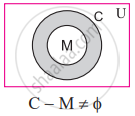Advertisements
Advertisements
प्रश्न
Express the truth of the following statement by the Venn diagram.
Some members of the present Indian cricket are not committed.
उत्तर
U : The set of all human beings.
M : The set of all members of the present Indian cricket.
C : The set of all committed members of the present Indian cricket.

The above Venn diagram represents the truth of the given statement, i.e. C - M = Φ
APPEARS IN
संबंधित प्रश्न
Using truth table examine whether the following statement pattern is tautology, contradiction or contingency `(p^^~q) harr (p->q)`
Write the dual of the following statements:
Madhuri has curly hair and brown eyes.
Write converse and inverse of the following statement:
“If a man is a bachelor then he is unhappy.”
If p and q are true statements and r and s are false statements, find the truth value of the following :
( p ∧ ∼ r ) ∧ ( ∼ q ∧ s )
Express the following statement in symbolic form and write its truth value.
"If 4 is an odd number, then 6 is divisible by 3."
Examine whether the following statement (p ∧ q) ∨ (∼p ∨ ∼q) is a tautology or contradiction or neither of them.
Using the truth table prove the following logical equivalence.
p → (q ∧ r) ≡ (p ∧ q) (p → r)
Examine whether the following statement pattern is a tautology or a contradiction or a contingency.
(p ∧ q) → (q ∨ p)
Examine whether the following statement pattern is a tautology or a contradiction or a contingency.
(∼ p → q) ∧ (p ∧ r)
Prepare truth tables for the following statement pattern.
(p ∧ r) → (p ∨ ~ q)
Examine whether the following statement pattern is a tautology, a contradiction or a contingency.
q ∨ [~ (p ∧ q)]
Prove that the following statement pattern is a tautology.
(~ p ∨ ~ q) ↔ ~ (p ∧ q)
Prove that the following statement pattern is a contradiction.
(p ∨ q) ∧ (~p ∧ ~q)
Prove that the following statement pattern is a contradiction.
(p ∧ q) ∧ ~p
Show that the following statement pattern is contingency.
(p → q) ↔ (~ p ∨ q)
Write the dual of the following:
~(p ∨ q) ∧ [p ∨ ~ (q ∧ ~ r)]
Write the dual of the following:
~(p ∧ q) ≡ ~ p ∨ ~ q
Write the dual statement of the following compound statement.
13 is prime number and India is a democratic country.
Write the negation of the following statement.
All the stars are shining if it is night.
Write the negation of the following statement.
∀ n ∈ N, n + 1 > 0
Using the rules of negation, write the negation of the following:
~(p ∨ q) → r
Using the rules of negation, write the negation of the following:
(~p ∧ q) ∧ (~q ∨ ~r)
With proper justification, state the negation of the following.
(p ↔ q) v (~ q → ~ r)
Construct the truth table for the following statement pattern.
(p ∨ r) → ~(q ∧ r)
What is tautology? What is contradiction?
Show that the negation of a tautology is a contradiction and the negation of a contradiction is a tautology.
Determine whether the following statement pattern is a tautology, contradiction, or contingency.
[(p ∧ q) ∨ (~p)] ∨ [p ∧ (~ q)]
Determine whether the following statement pattern is a tautology, contradiction, or contingency.
[p → (~q ∨ r)] ↔ ~[p → (q → r)]
Using the truth table, prove the following logical equivalence.
p ∧ (~p ∨ q) ≡ p ∧ q
Using the truth table, prove the following logical equivalence.
p ↔ q ≡ ~(p ∧ ~q) ∧ ~(q ∧ ~p)
Write the dual of the following.
(p ∧ q) ∧ r ≡ p ∧ (q ∧ r)
Write the dual of the following
(p ˄ ∼q) ˅ (∼p ˄ q) ≡ (p ˅ q) ˄ ∼(p ˄ q)
The contrapositive of p → ~ q is ______
Complete the truth table.
| p | q | r | q → r | r → p | (q → r) ˅ (r → p) |
| T | T | T | T | `square` | T |
| T | T | F | F | `square` | `square` |
| T | F | T | T | `square` | T |
| T | F | F | T | `square` | `square` |
| F | T | T | `square` | F | T |
| F | T | F | `square` | T | `square` |
| F | F | T | `square` | F | T |
| F | F | F | `square` | T | `square` |
The given statement pattern is a `square`
If p, q are true statements and r, s are false statements, then find the truth value of ∼ [(p ∧ ∼ r) ∨ (∼ q ∨ s)].
